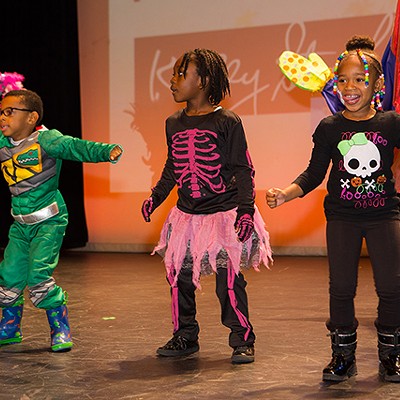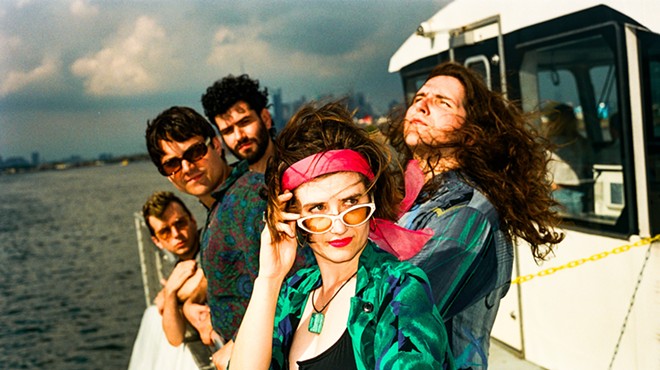Monday, April 22, 2013
Nora Chipaumire at the Kelly-Strayhorn
Noted choreographer Chipaumire’s latest dance work was dreamlike, by which I mean it was both partly memorable and largely baffling. And the latter quality, it appears, is by design.
More performance-art-with-dance than straight dance piece, Miriam consisted of two performers on an artfully cluttered, dimly lit stage, developing a mostly nonverbal relationship. I saw it Saturday night, the second of two weekend performances at the Kelly-Strayhorn.
The characters’ relationship had an Ariel-and-Caliban quality. The tall, lithe and rather imperious Okwui Okpokwasili, wearing a pair of tattered wings, contrasted the more sturdily built Chipaumire, whose vocal emanations were mostly a series of birdlike squeals and guttural grunts. In its serious comedy, it was also a bit suggestive of Beckett, but without the dialogue to carry you through.
The show’s opening sequence was striking. Chipaumire — first seen only as a bare, disembodied leg poking skyward — emerges with noisy thrashing from what appears to be a pile of trash, then approaches Okpokwasili, who is perched upstage, on a ladder. Shortly Okpokwasili descends, and a relationship that began with her giving choreographic orders to Chipaumire (through a megaphone) becomes more equal and even playful, if negotiated mostly in a glossolalia incomprehensible to the audience. It was all done to a first-rate sound design incorporating everything from percussive music and spoken word to electronic soundscapes.
Zimbabwe-born, New York-based Chipaumire has an international resume, including both her solo projects and her six years with the Urban Bush Women. She’s got a strong track record in Pittsburgh, too: Her solo work Chimurenga (which she performed in 2007 at the New Hazlett Theater) still ranks among the most powerful shows I’ve ever seen here. Both she and Okpokwasili are skilled, committed performers.
Miriam, meanwhile, came with no shortage of explanatory prefaces. Interviewed for a preview article by CP’s Steve Sucato, for instance, Chipaumire said that Miriam is about public personae, as reflected in the iconic figures and stories of both Miriam Makeba and the Virgin Mary. Elsewhere, she’s said that inspirations for the show include Joseph Conrad’s Heart of Darkness.
All of which is surely true. (And there's a sung version of "Hail Mary" on the soundtrack, and I think at least one read-out excerpt from Conrad.) But in a 500-word essay included in the Kelly-Strayhorn show’s program, Chipaumire mentioned none of these influences, choosing instead to talk about otherness — the quality of being an outsider. It’s a feeling Chipaumire knows well. And in her essay, she writes that with Miriam, she means to make the audience itself feel like outsiders.
I’d say she succeeded, though that’s a goal difficult to reconcile with simultaneously engaging that same audience: For me, Miriam largely defied comprehension (and I’m pretty sure I wasn’t alone). And the occasional complete stage blackout was less a problem than was the fact that almost the entire rest of the show was performed in half-light. (Imagine a whole proscenium stage lit by a couple dozen low-wattage bulbs.)
This setup did make possible some fine effects, including a climactic dance by Chipaumire in a sort of voluminous cloak rendered powerfully mysterious in the dim. But while the nonlinear sound design was suitably suggestive, mostly, the darkness just made things hard to see.
“By playing with the ability to see or not see, I am trying to complicate the question of power while engaging, and challenging, theater traditions in the West,” Chipaumire writes. And if viewers end up dumbfounded, well, “Taking away the ‘right’ of the audience to comfortably comprehend is my attempt at bringing the audience towards what it feels like to be the other.”
Chipaumire played with similar ideas in the previous show she performed here, lions will roar, swans will fly, angles with wrestle heaven, rains will break: gukurahundi, in which the dancers spent most of the show behind a downstage scrim.
It’s good that artists like Chipaumire are pushing boundaries. Theater-goers probably benefit from a certain amount of disorientation; in most ways, it’s preferable to spoon-feeding. But perhaps it's possible to meet audiences a little closer to halfway.
Tags: Nora Chipaumire , Miriam , Kelly-Strayhorn Theater , Program Notes














